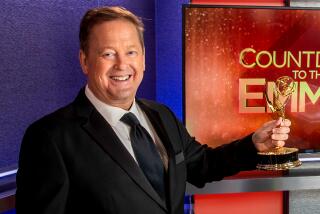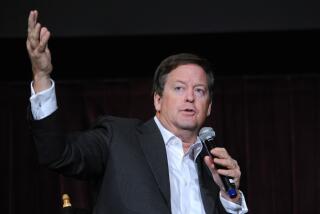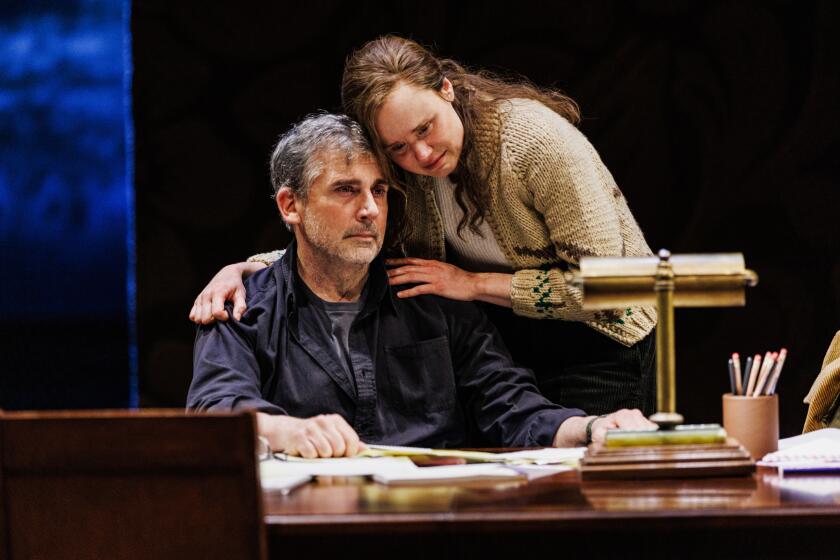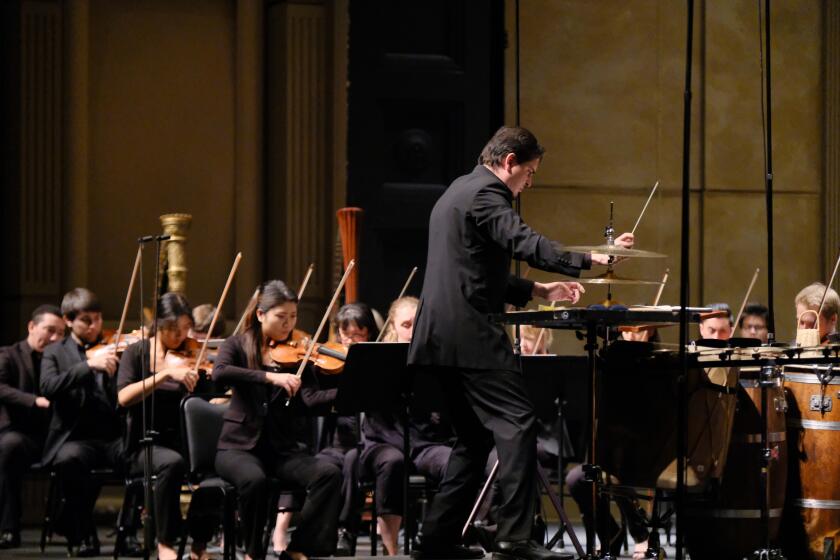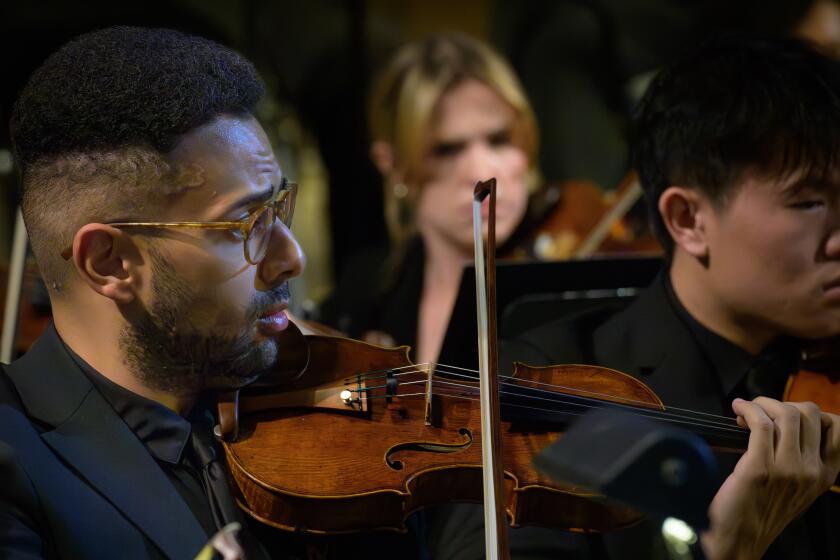A Musical State of the Nation Report
What do a gamelan orchestra, a St. Louis beer vendor and a Mississippi railroad have in common? They’re all part of a project called “Continental Harmony,” the largest music-commissioning undertaking in American history, according to its sponsor, the service organization American Composers Forum, headquartered in St. Paul, Minn.
The idea was to match new music to the new millennium by linking composers and communities in all 50 states to create work that would reflect the history, culture and ambitions of their residents.
Launched in 1998 with a $750,000 grant from the National Endowment for the Arts, the collaborations have so far produced 58 compositions in styles ranging from jazz and choral to opera and orchestral. To underscore the national sweep of the project, many were premiered on July 4, 2000.
Among them were works written by Thomas Oboe Lee for the Culver City-based American Jazz Philharmonic, and by Han Young for Sacramento’s Camellia Symphony Orchestra. “Full of fascinating sounds, absorbingly wrought ... unexpected,” a critic at the Sacramento Bee wrote.
Along the way, the Knight Foundation sought a proposal from Minnesota public television to document the project, and its 60-minute report can be seen in Los Angeles tonight on KCET. Executive produced by Catherine Allan, the documentary traverses the country from Scottsville, Ky., to the base of the Grand Canyon, focusing on the stories of a handful of composers and the communities they were assigned to capture.
The message of “Continental Harmony”--that music has the power to unite, heal and uplift--perhaps seems more relevant now than when it was first conceived. Speaking by phone from Minnesota, American Composers Forum executive director Linda Hoeschler agrees. “One reason the TV show is being picked up is that this is a time in our nation [when] we need to feel good about ourselves.
“Every [chosen] site I went to made you want to cry. In Grand Forks, North Dakota, a choral work was written about their [1997] flood. People hugged me when it was over.”
Hoeschler, a new-music devotee who has been at the forum for the last decade, says she had always wanted to do a community-based commissioning project. When asked by the NEA if she had any ideas on how to celebrate the millennium while serving the “urban underserved,” she drafted a plan, inviting 12,000 communities to form committees and apply to work with a composer for a number of weeks on a custom composition.
Applications were submitted by nearly 200 towns, cities or regions, with the composers’ forum ultimately choosing 58 sites. These proposals--which included themes suggested by the communities--were then submitted to a database of more than 5,000 composers, who could apply for up to three projects each. Communities ultimately selected their own composers from among those applications.
“It was like a first year of marriage,” she notes, “because if you come into it willingly, you’ll make it last at least that long. As a result, every project went from start to finish. The process was as important as the product.”
Among the composers featured in the documentary is Jaron Lanier, who hooked up with Jim Meredith, music director of Oakland’s Handbell Ensemble Sonos, along with two San Jose groups, San Jose Taiko (traditional Japanese drumming), and Pusaka Sunda, (a gamelan troupe). Meredith and company wanted a composition that would reflect Pacific Rim diversity and explore San Francisco Bay Area ecology.
Lanier, 41, is also a computer scientist who is said to have coined the term “virtual reality” two decades ago. He lives in New York and Sausalito, Calif., amid a collection of 1,000 instruments amassed from around the world. Active in the arena of new music since the late 1970s, Lanier, who studied piano and plays computer-based instruments, has performed with such diverse talents as Philip Glass and jazz ace Ornette Coleman. As it turns out, this match came about a little outside the usual bounds of the project. When the Oakland-San Jose proposal didn’t find any takers among the composers in the database, Meredith, who knew Lanier’s work, called the composer and asked him to consider applying.
Lanier liked the challenge of dealing with such different instruments. He met with the Bay Area musicians and tackled the problem with the aid of computer sampling.
“I imagined some fictitious culture that had a complicated harmony structure,” he explains. “[As] none of these instruments have any notes in common, I did it initially by playing with different chord combinations. I tried to get something analogous to a mode within these weird harmonies. I didn’t want it to sound alien or too challenging, but something that would be a fun, accessible piece.”
The 20-minute work was premiered at Berkeley’s First Congregational Church in May 2000 and performed in other Bay Area cities. Teeming with overtones, with shades of Lou Harrison’s California eclecticism, it’s textural and ethereal. But what do bells, drums and Indonesian gongs have to do with Bay Area ecology?
Lanier says he had heard a story about an ancient redwood tree in the Oakland hills. “It was called the Navigator Tree and could be seen from the sea,” he says. “If you sailed toward it, you would avoid the dangerous underground shoals in the bay. The tree was cut down in the mid-19th century, and the immediate consequence [was] that the bay became unnavigable. I visited the stump--it’s as big as a house--and thought the tree needed a memorial.”
“The Navigator Tree” is Lanier’s musical monument to the tree that once stood in what is now Roberts Regional Park. In its Berkeley performances, the work earned standing ovations.
Many of the other “Continental Harmony” matches took composers to unfamiliar places. Composer Phillip Bimstein, who is also mayor of Springdale, Utah, and a former new-wave band member, landed in St. Louis and in the documentary.
After roaming the city for a few weeks, he decided to explore the aural treasures of Busch Stadium. The outcome was a piece that made use of his St. Louis commission to incorporate a classically trained wind quintet and the sounds of a baseball game in his “Bushy Wushy Rag.” The sonorous voice of a beer hawker, Robert Logan, was mixed with ballpark sounds to create a Scott Joplin-infused ragtime piece. It premiered at Fair St. Louis to an ebullient crowd of 100,000.
On a more serious note, the documentary also highlights Anne Le Baron’s composition, “Traces of Mississippi.” A Pittsburgh harpist-composer, LeBaron worked with Madison County, Miss., poets, singers and a chamber orchestra to try to unify a county divided by race and economics. In addition, LeBaron employed the sounds of the local railroad, a metaphor for movement and bringing people together, in her work that featured 100 performers.
According to Patricia A. Shifferd, the American Composers Forum program director for “Continental Harmony,” most of the 58 compositions have been recorded, although no CDs have been issued yet. And the program, which Hoeschler likens to the 1930s Works Progress Administration arts projects, is ongoing. New applications have been sent out, and composers and communities have again been matched up, with performances scheduled to begin next fall.
“We are doing 17 to 18 sites every year until 2005--a third of the states; but we expect to continue on after that,” Hoeschler says. “Continental Harmony has given us huge credibility [and] helped put us on the map--or made sure we stayed on the map. The other thing it’s done is inspired people. We felt we did so much good with this project that [many] communities called and asked if they could do it again. The emphasis was on the positive. If you come together with celebration in mind, that will cause underlying problems to begin to be addressed.”
*
“Continental Harmony” airs today at 6 p.m. on KCET.
More to Read
The biggest entertainment stories
Get our big stories about Hollywood, film, television, music, arts, culture and more right in your inbox as soon as they publish.
You may occasionally receive promotional content from the Los Angeles Times.
